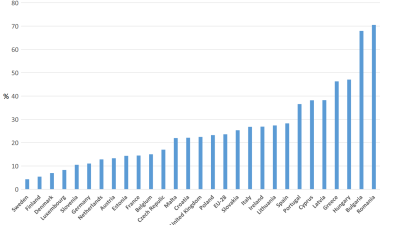Two separate analyses have found that women are bearing the brunt of austerity measures introduced by the Coalition government. One analysis, by the House of Commons Library, calculates that nearly 75 per cent of budget savings since 2010 have primarily hit women’s incomes. A second analysis, by the Women’s Budget Group, examines the most recent (2012) Budget.
House of Commons research
The Commons Library traces the gender impact of a long list of fiscal measures, starting with the 2010 Budget. The combined impact – by reference to projected government revenues in 2014/15 – is calculated to be £14.9 billion, of which £11.1 billion (74.5 per cent) will fall primarily on women.
The most severe impacts derive from changes to public sector pension arrangements (£6.1 billion), the tapered removal of child benefit from higher-rate taxpayers (£1.6 billion), and the decision to freeze child benefit for three years (£1.3 billion).
The document can be found here. There is also a related Guardian report (30 March 2012).
Women’s Budget Group analysis
The Women’s Budget Group’s gender impact assessment of the March 2012 Budget finds that:
- The planned extra £10 billion cut from ‘welfare’ spending by 2016/17 will have a ‘devastating’ impact on women, one-fifth of whose average income consists of benefit payments.
- Women account for two-thirds of employment in the public sector, and therefore face the brunt of a further 30,000 job losses in the sector between 2011 and 2017.
- Because more women work in the public than in the private sector, with a particularly high concentration in certain regions, they will be worst affected by proposed ‘regional pay’ rates in the public sector.
The analysis (The Impact on Women of the Budget 2012, Women’s Budget Group) is available on the Women’s Budget Group website. See also their press release. (The Women’s Budget Group is an independent organisation bringing together people from academia, non-governmental organisations and trade unions.)
More details on the 2012 budget can be found in The Impact of the budget on low income households.



 PSE:UK is a major collaboration between the University of Bristol, Heriot-Watt University, The Open University, Queen's University Belfast, University of Glasgow and the University of York working with the National Centre for Social Research and the Northern Ireland Statistics and Research Agency. ESRC Grant RES-060-25-0052.
PSE:UK is a major collaboration between the University of Bristol, Heriot-Watt University, The Open University, Queen's University Belfast, University of Glasgow and the University of York working with the National Centre for Social Research and the Northern Ireland Statistics and Research Agency. ESRC Grant RES-060-25-0052.






